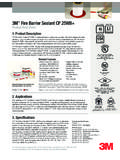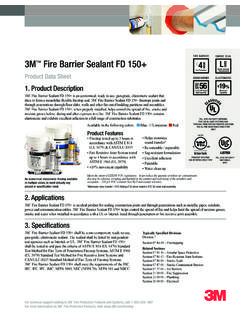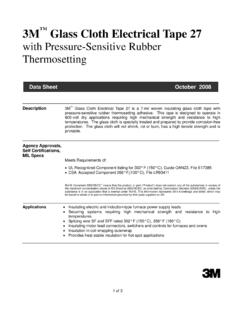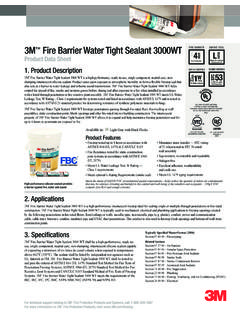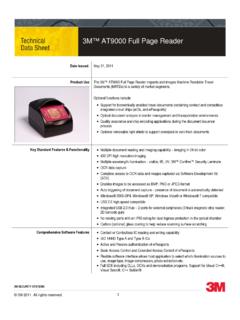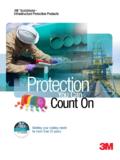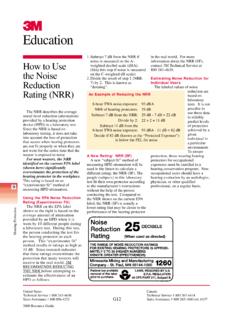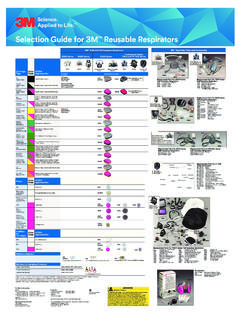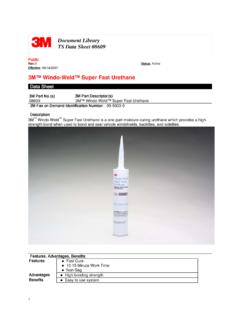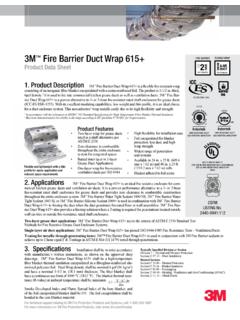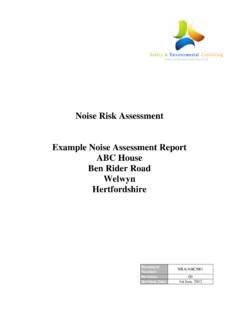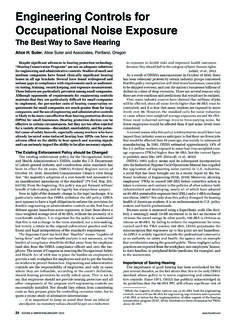Transcription of OSHA’s Noise Standard Defines Hazard, Protection
1 United StatesCanadaTechnical Service 1 800 243-4630 Technical Service 1 800 267-4414 Sales Assistance 1 800 896-4223 Sales Assistance 1 800 265-1840 ext. 6137G192000 Resource GuideEducationHearing ProtectionGOSHA sNoise StandardDefines Hazard, ProtectionWalsh-Healey Noise StandardAlthough OSHA s hearingconservation amendment (HCA)came out in a flurry of publicityabout a decade ago, the noisestandard to which it was amendedhas actually been around for quite awhile. In 1969, shortly before OSHA came into being, the Department ofLabor issued a Noise Standard underthe authority of the Walsh-HealeyPublic Contracts Act.
2 This meantthat the Standard applied to allemployers having contracts with thefederal government. In 1971, thestandard became an OSHA Standard ,and along with a large number ofother government and consensusstandards, it became the law for allnoisy workplaces in the nicknamed the Walsh-Healey Noise Standard , it calls for amaximum Noise exposure level of 90dB(A) as an 8-hour, time-weightedaverage level (TWA). Higher levelsare permitted for shorter durations,with a 5-dB relationship betweennoise level and duration (see Table3). Thus, 95 dB(A) is permissible for4 hours, 100 dB(A) for 2 hours, andso forth, up to a maximum exposurefor continuous Noise of 15 minutes at115 dB(A).
3 Continuous Noise isdefined as Noise whose maxima(highest levels) occur more oftenthan once per second. Thus,impulsive Noise is assumed to havepeaks occurring less often than oncea second, and is limited to peaksound pressure levels of 140 must use feasibleengineering or administrativecontrols to reduce exposureswhenever the levels in Table 3 areexceeded. Employers must also issuehearing protectors and employeesmust wear them when the Standard was amended in1981, it also required a continuing,effective hearing conservationprogram whenever employees wereexposed to levels exceeding those inTable 3, but this section has nowbeen replaced by the Process of RevisionShortly after the Noise standardwas adopted by OSHA, controversyarose as to the definition of a continuing, effective hearingconservation program.
4 The standarditself offered little clarification andOSHA s guidelines on the subjectwere challenged as not having theweight of a regulation. The processof revising the Standard , whichwould seem simple enough, lastedmore than a decade. NIOSH sentOSHA a criteria document in 1972,recommending a reduction of thepermissible exposure limit (PEL) to85 dB(A), and giving detailedspecifications for hearingconservation programs. OSHA called together an advisorycommittee, invited public comment,drafted economic impact statements,issued a proposed revised standardand held public hearings. The majorissues revolved around: (1) the PEL,whether it should be 90 or 85 dB(A);and (2) the method of control,whether to keep the primacy ofengineering and administrativecontrols, or to allow hearingprotectors to have equal , after years of deliberation,OSHA decided to leave the PEL at90 dB(A) and to affirm engineeringand administrative controls as theprimary means of compliance, but toamend the Standard with detailedrequirements for hearingconservation published the HCA onJanuary 16, 1981.
5 Under mostcircumstances the regulation wouldhave become effective (enforceable)in April of that year. On January 20,however, there was a change ofadministration and OSHA s topmanagement was completelyreshuffled. The new administrationdelayed the amendment s effectivedate, releasing part of the Standard inAugust of 1981, and makingrevisions to other parts. The revisedversion was finally issued in 1983and has not been altered since requirements for hearingprotectors remained essentiallyunchanged between 1981 and with theresponsibility for hearingconservation programs shouldbecome thoroughly familiar with therevised version of the HCA.
6 It maybe found as CFR in theCode of Federal Regulations, whichis available from the GovernmentPrinting Office at (202) who has access to theFederal Register can also find it inthe March 8, 1983 issue of theFederal Register, pages actual Standard appears on pages9776-9784, which is, of course, themost important section. Much of theTable 3 OSHA s Table G-16 ShowingPermissible Noise ExposuresSound level,Duration perdB(A) slowday (hours)response89069249539721001-1/21021 1051/21101/4 or less115(continued on next page)United StatesCanadaTechnical Service 1 800 243-4630 Technical Service 1 800 267-4414 Sales Assistance 1 800 896-4223 Sales Assistance 1 800 265-1840 ext.
7 6137G202000 Resource GuideEducationHearing ProtectionGOSHA s NoiseStandardcontinued from page G19standard is explained in the preambleof the 1981 version, found in theJanuary 16, 1981 issue of the FederalRegister, pages 4078-4179. TheCode of Federal Regulations and theFederal Register are available inmany of the HearingConservation AmendmentTo summarize the current HCA smajor provisions, hearingconservation programs must beavailable to all employees whoseTWAs equal or exceed 85 dB(A).Employers must monitor, at leastonce, the Noise exposures of workerswhose TWAs are 85 dB(A) orgreater.
8 Remonitoring is necessarywith a change in equipment or workprocess that causes a significantincrease in exposure level. Allcontinuous, intermittent, andimpulsive Noise between the levelsof 80 and 130 dB(A) must beincluded in the exposure monitoring is permitted, butemployers must use personalexposure monitoring when there isconsiderable variation of Noise levelover time. Workers must be allowedto observe the monitoringprocedures and must be told abouttheir must provide baselineaudiograms within the first sixmonths of an employee s exposure to85 dB(A) or above (or one year ifthe company uses mobile testservices), and annual audiogramsmust be provided thereafter.
9 The testmust be conducted by trained andcompetent personnel and supervisedby an audiologist or physician. Testsmust be carried out in rooms thatmeet or exceed the 1969 ANSI criteria for background sound levels,and equipment must be calibratedaccording to specific who experience Standard threshold shifts must be notified inwriting, counselled as to the fittingand use of hearing Protection , andreferred to a specialist if necessary. Astandard threshold shift is defined asan average shift from baselinehearing levels of 10 dB or more atthe audiometric frequencies 2000,3000, and 4000 Protection must beprovided at no cost to employees andmust be worn by all workersexposed to a TWA of 90 dB(A) andabove.
10 Hearing Protection is alsomandatory for those exposed to 85dB(A) and above if they have not yethad a baseline audiogram and for allemployees who have experienced astandard threshold shift. Employersmust offer hearing protectors toworkers exposed above 85 dB(A),and all must be given a variety ofsuitable protectors from which tochoose. Employees must be trainedin the use and care of the must ensure proper initialfitting of protectors and need tosupervise their correct use. Hearingprotectors must attenuate to a TWAof 90 dB(A) or less and to 85 dB(A)when employees have experienced astandard shift.
